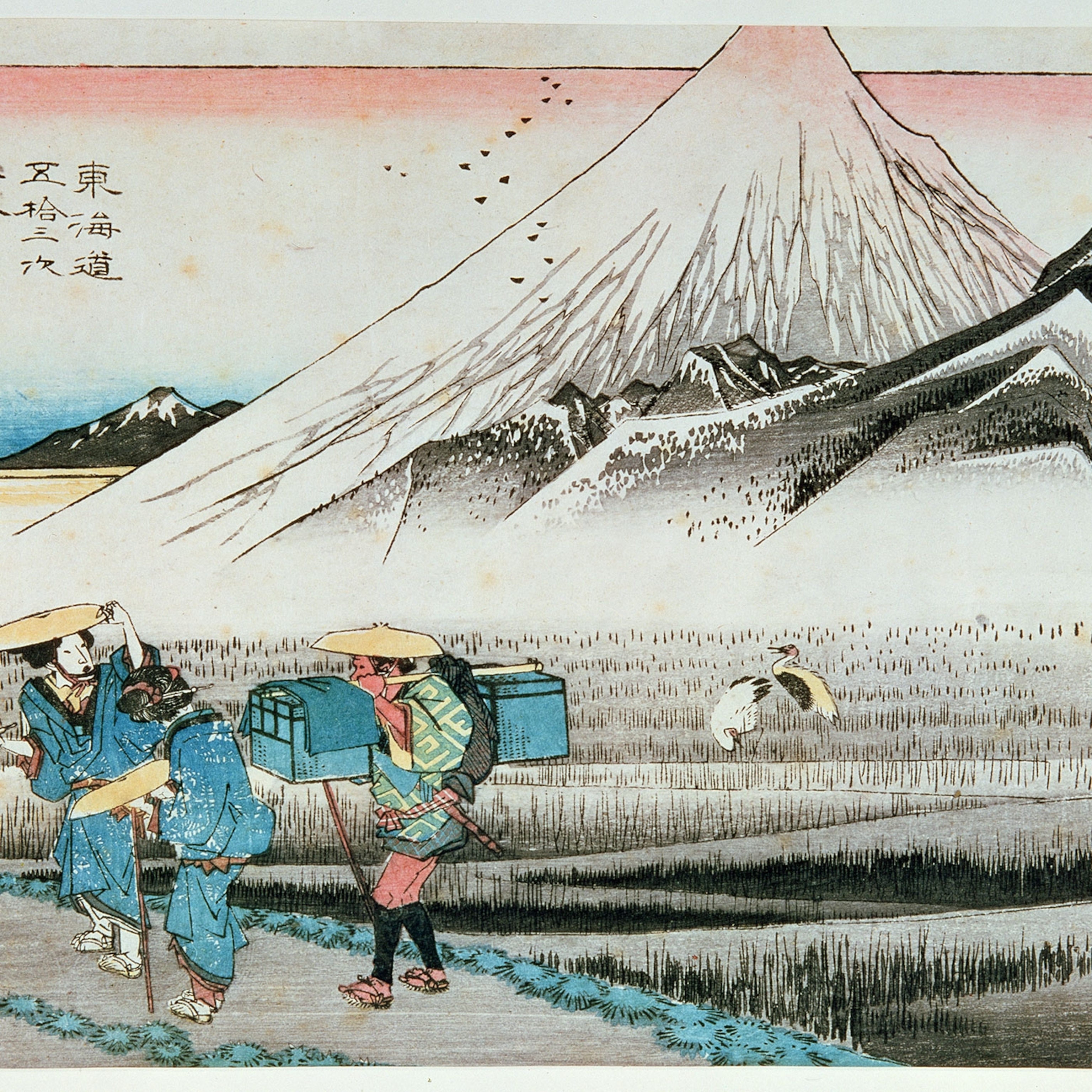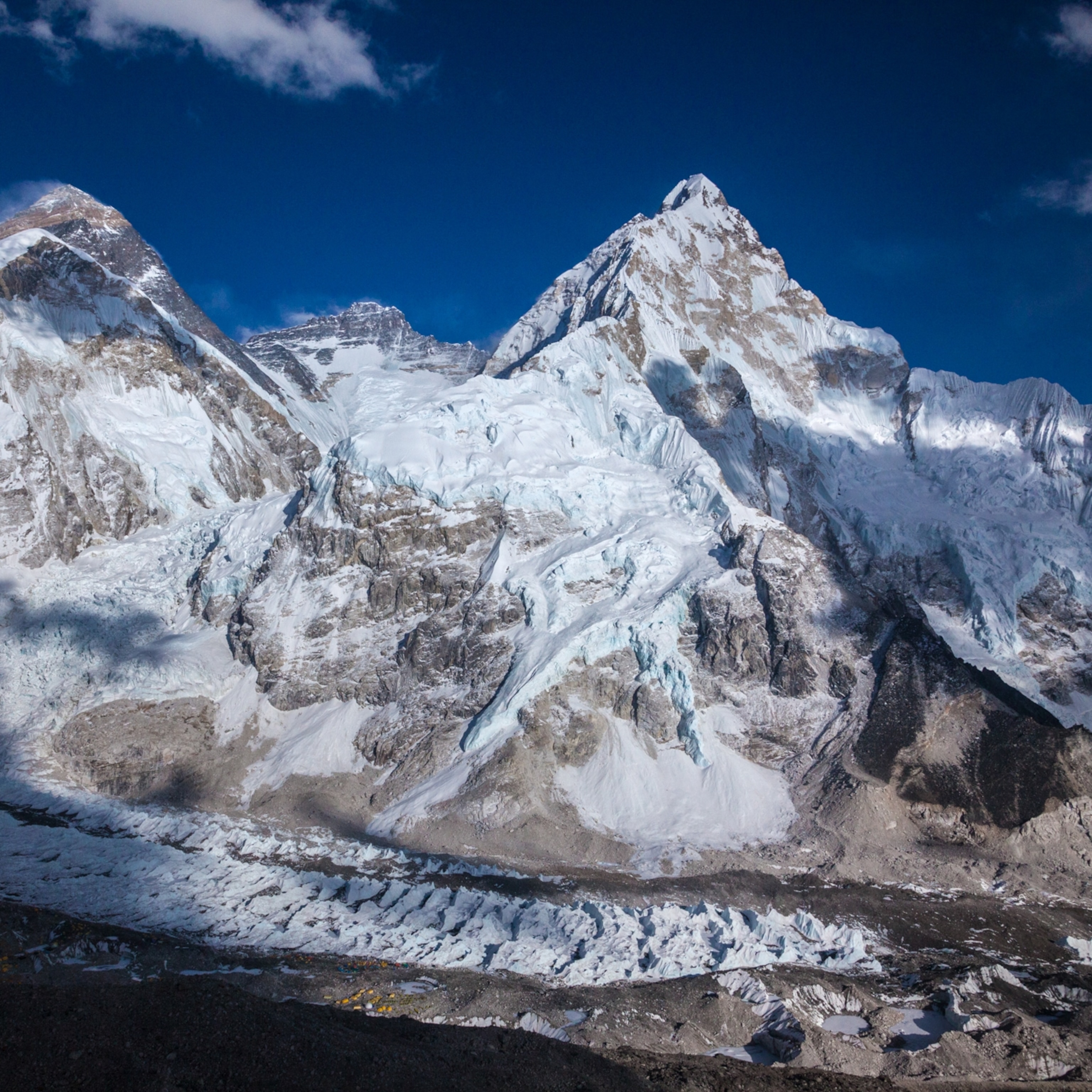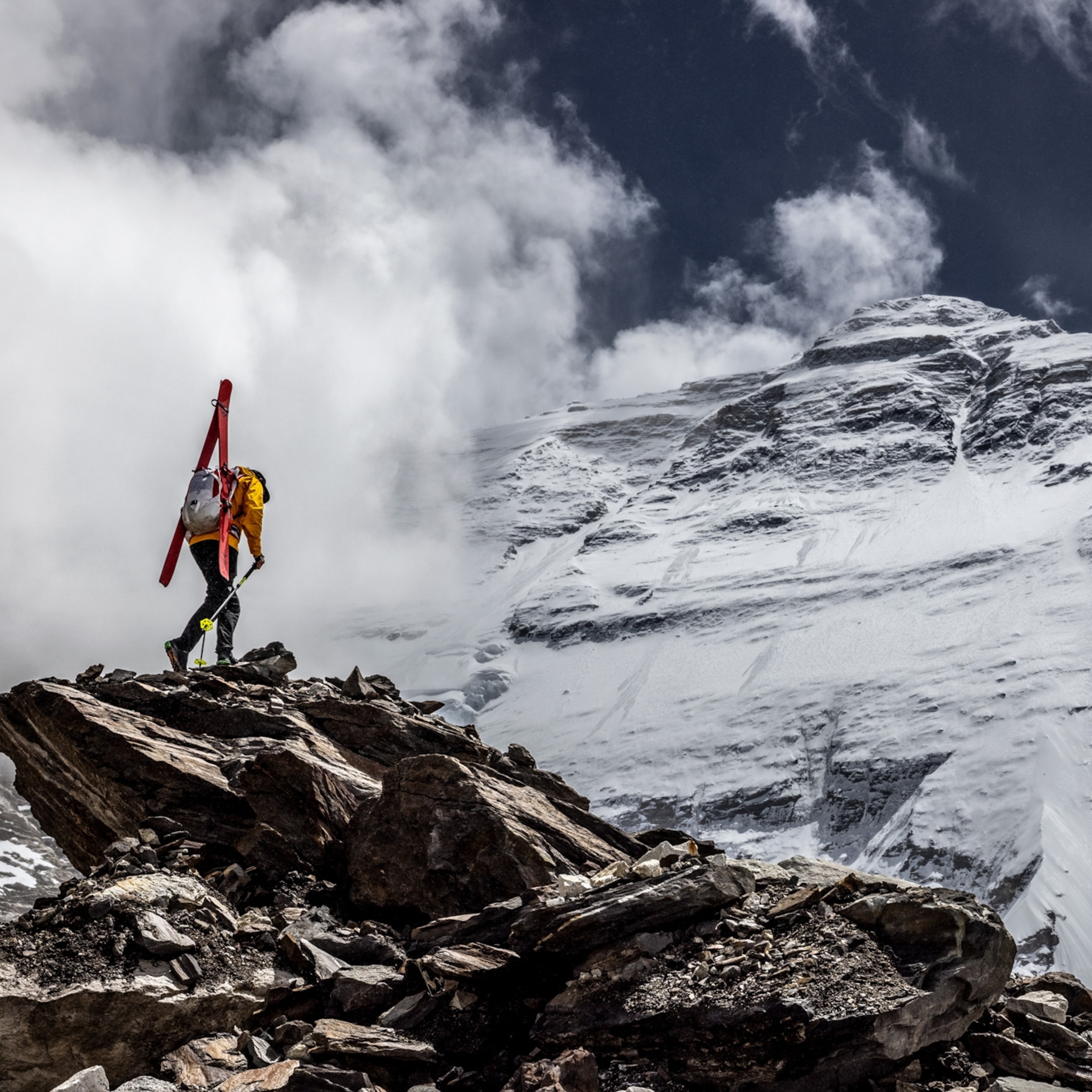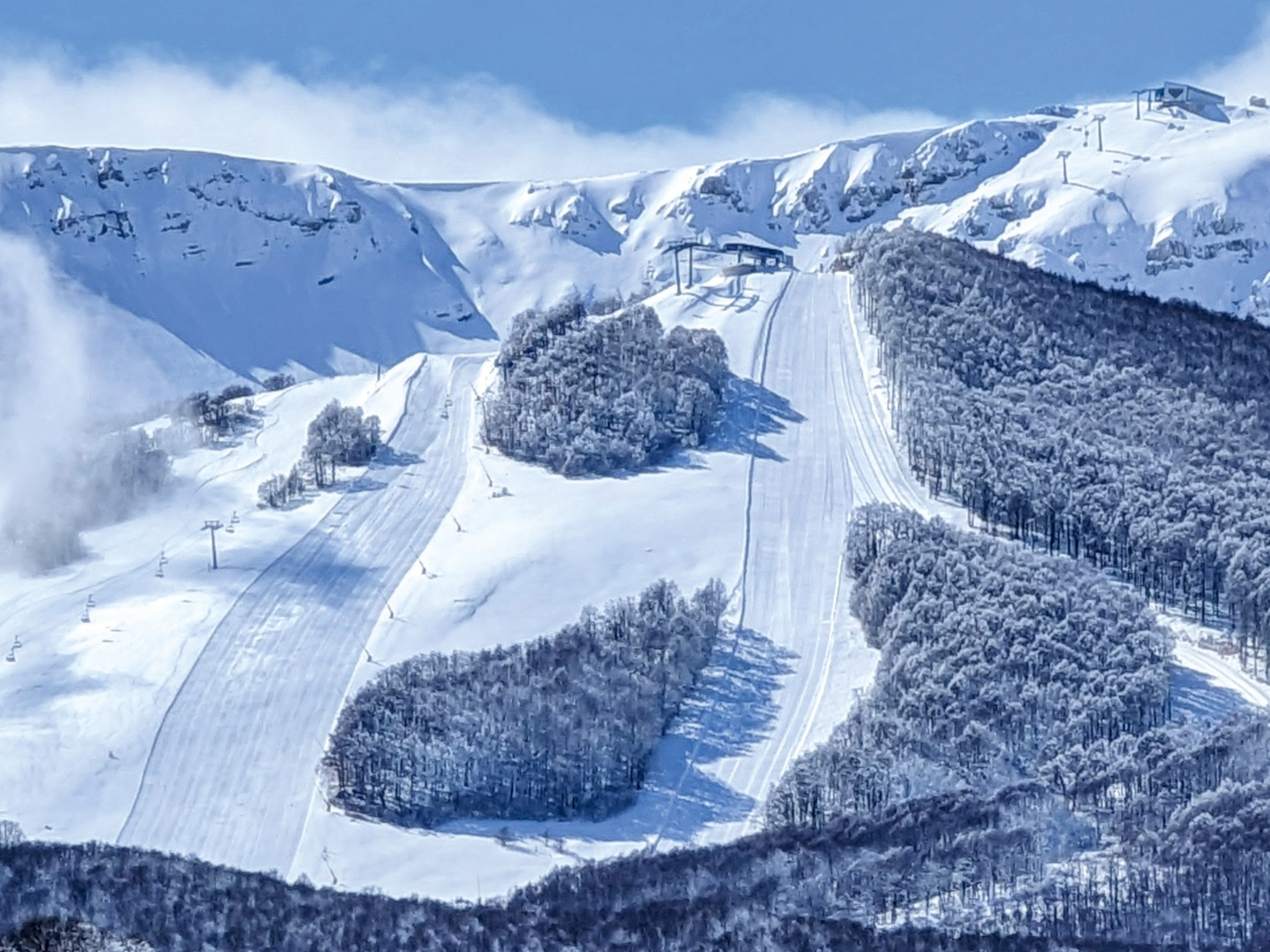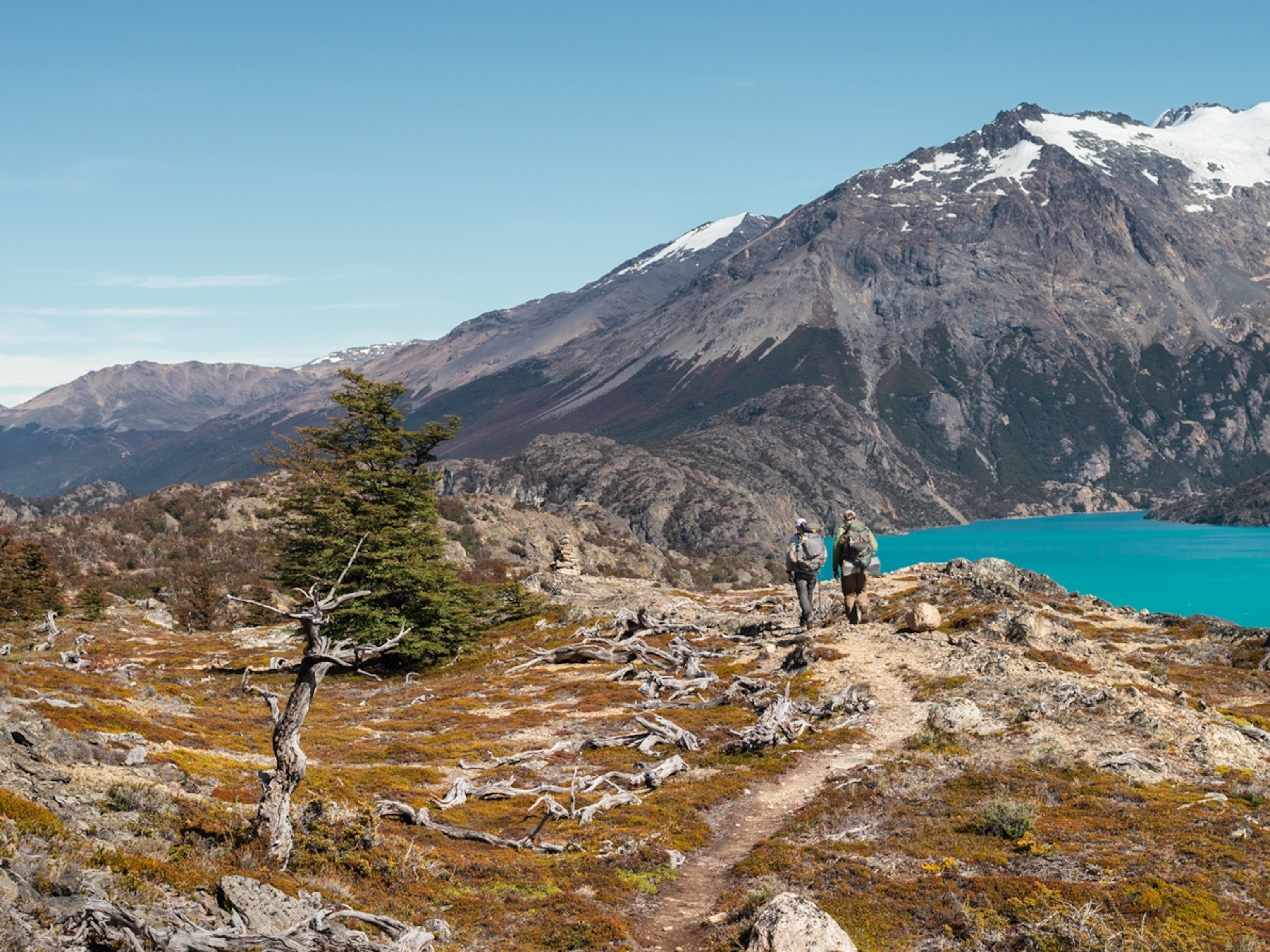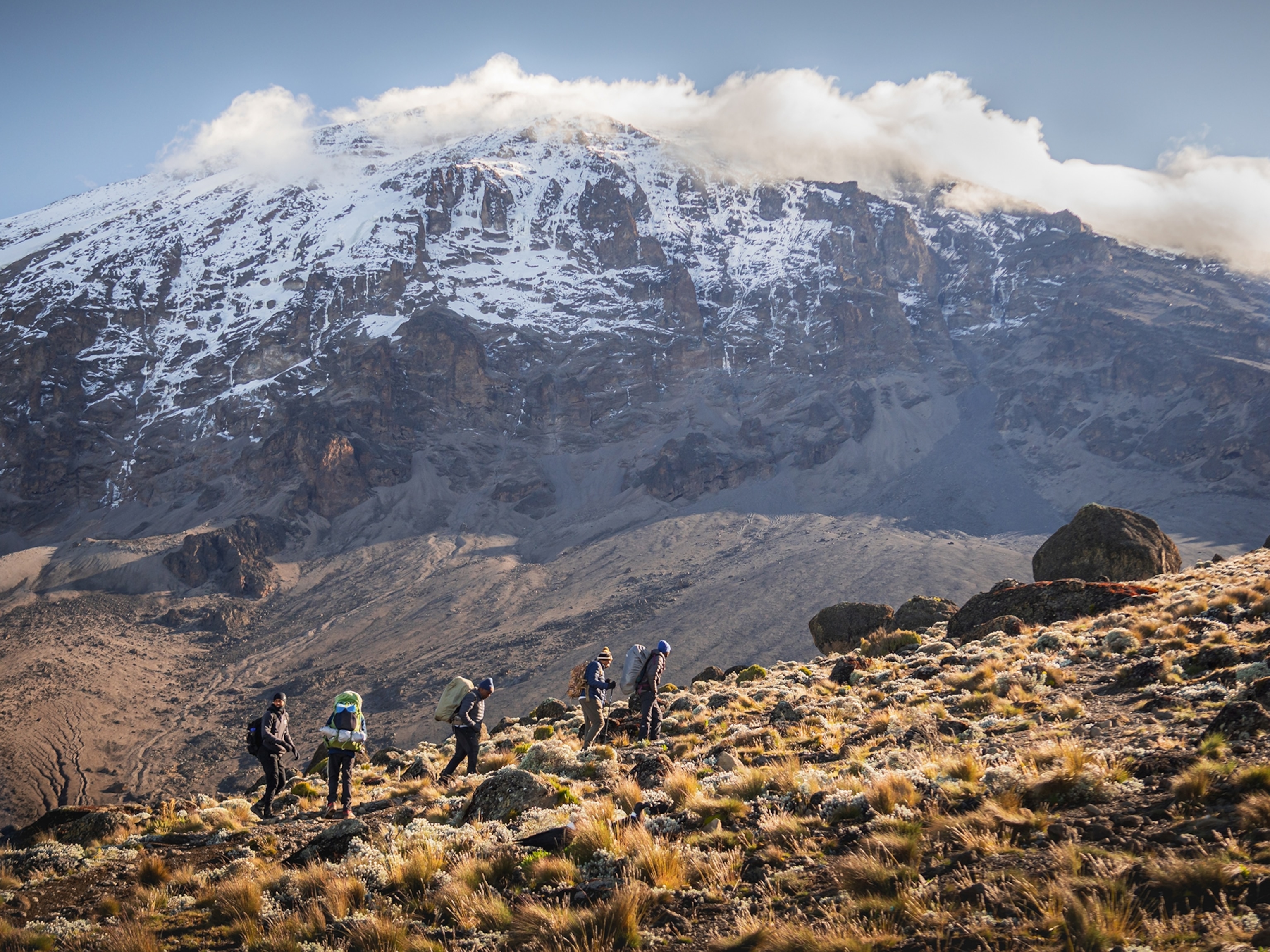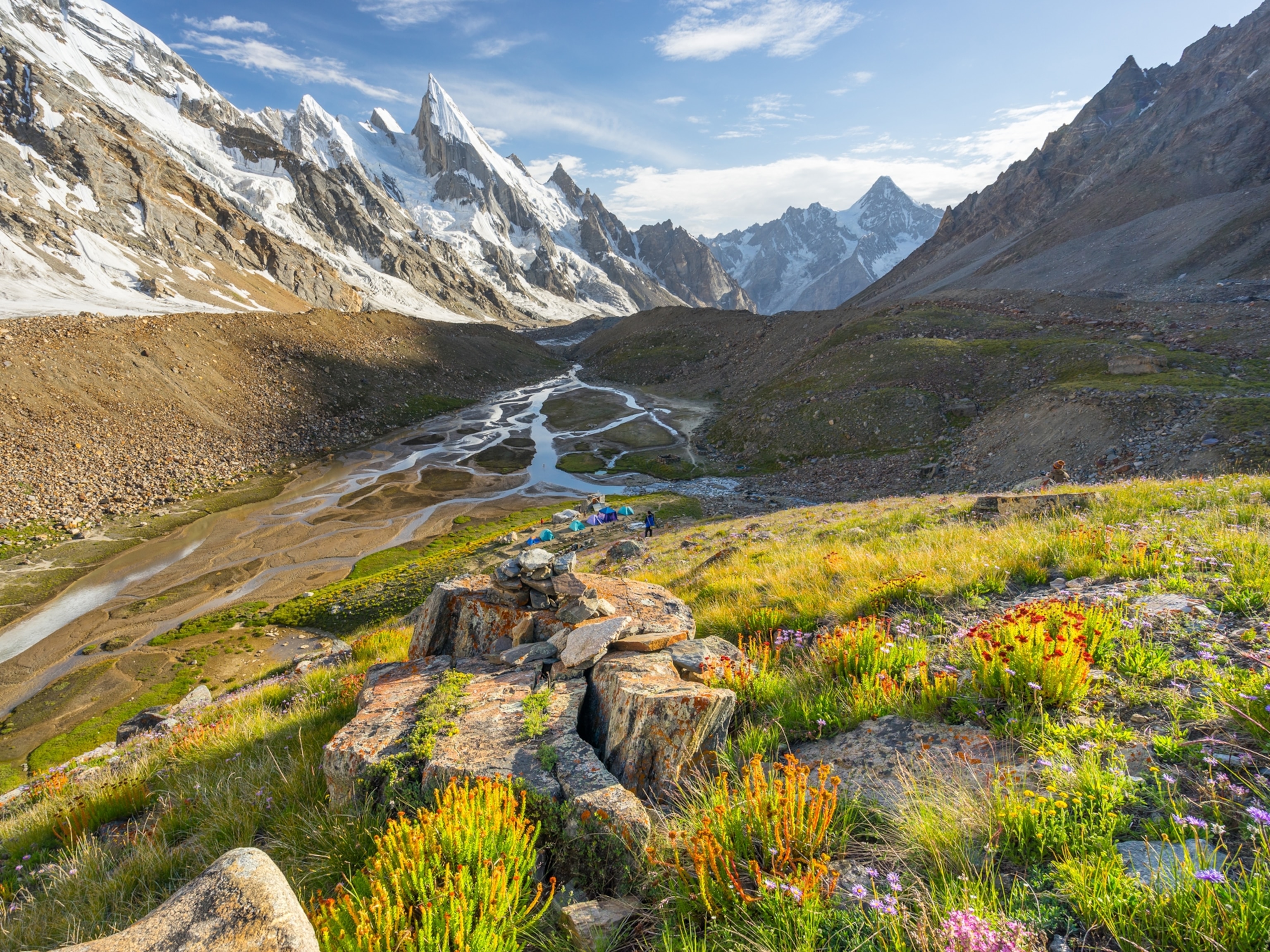
How an all-Nepali team pulled off one of the most dangerous climbs in history
Driven by national pride, 10 elite mountaineers united to make it the top of K2 in the dead of winter
Swallowed by the empty black night, Mingma Gyalje Sherpa tried to focus the shaky orb of his headlamp on his next few steps, but the cold overwhelmed his thoughts. Clad in a bulky down suit, with another down jacket underneath, plus two layers of long underwear and breathing bottled oxygen, he should have been OK. But in all the peaks he’d summited, all the blizzards and frigid gales he’d weathered, he’d never felt temperatures quite like this—a piercing, otherworldly cold.
He could sense his body shutting down. His left side bore the brunt of a stout wind, with each gust sending icy tendrils slicing through everything he wore. But his right foot was especially worrisome. It had tingled, then burned, and finally ebbed into numbness, a precursor to serious frostbite. That, he knew, was a sign his body was prioritizing blood flow to warm vital organs, sacrificing the extremities to preserve the core. And this was all happening before he’d even crossed into the so-called Death Zone—the region above 8,000 meters (26,247 feet)—where the lack of oxygen can cause climbers to hallucinate, retain fluid in their lungs, and lose their instinct for self-preservation.
Mingma G.—as he’s known—keyed his radio, his mind momentarily made up to turn around. “Dawa Tenjin? Dawa Tenjin?” he called, but only the whining wind answered. He could make out the dim lights of several teammates trudging in a broken line up the low-angle snow above him. Everyone must be too focused on the tasks at hand, or just too deep in their own suffering, to answer, he thought.
Even in the milder summer months, K2, the second highest peak on Earth at 28,251 feet, is among the world’s deadliest mountains. Though it’s more than two football fields shorter than Mount Everest, getting to its summit requires a much higher degree of climbing skill and almost no margin for mistakes. American climber George Bell, after failing to summit in 1953, declared, “It’s a savage mountain that tries to kill you.” The nickname has stuck, in part because for roughly every four climbers who make it to the top and back down, another one dies in the attempt.

But now, almost four weeks after the winter solstice, when the Northern Hemisphere tilts farthest away from the life-giving warmth of the sun, the conditions on the mountain are some of the harshest on the planet. The windchill temperature on its upper reaches can drop to minus 80 degrees Fahrenheit—roughly the same as the average temperature on Mars.
And yet, this was a moment Mingma G. had been dreaming about. Even as he laboriously kicked his numb right foot into a patch of ice in a desperate attempt to stave off frostbite, he knew some of his teammates were fixing sections of rope to the mountain using an array of ice screws, pitons, and snow pickets, building a secure trail to follow toward the summit.
For most experienced mountaineers, the thought of climbing K2 in winter was lunacy. Six serious expeditions had attempted the feat, but none had come close to the top. There seemed to be too many challenges to overcome: unpredictable hurricane-force gusts that could blow a string of roped climbers off in an instant; falling rock and ice that roared down like artillery; lung-starving, mind-muddling thin air; and the deep, unforgiving cold. Even the most resolute and experienced teams had withered under the brutal conditions, the pressures and dangers often causing them to implode with personal conflicts and leadership issues.
(Follow the all-Nepali team's winter route to the top of K2)
In the final months of 2020, some 60 climbers arrived at the foot of K2 on the remote Godwin Austen Glacier in Pakistan’s part of the Karakoram Range, all seeking the last remaining prize in high-altitude mountaineering—and arguably the toughest of them all. But for Mingma G. and his nine teammates, all Nepalis, the expedition offered more than just personal glory. It was a chance for them to prove that Nepal—a nation defined by some of the world’s biggest mountains—could achieve what many thought was impossible.
Now, as Mingma G. surveyed his situation, the path to K2’s elusive summit seemed tantalizingly within reach. But at what cost? He knew firsthand how a severe injury could forever alter his life. His father, also a mountain guide, had lost all but two of his fingers to frostbite when he’d removed his gloves to tie a foreign client’s bootlaces on Everest. What if one of his teammates lost a limb or was killed? Would the summit be worth it? For Mingma G. and the members of the expedition, even with a clear understanding of the risks and the deadly cold seeping into their bones, the answer was unanimous.
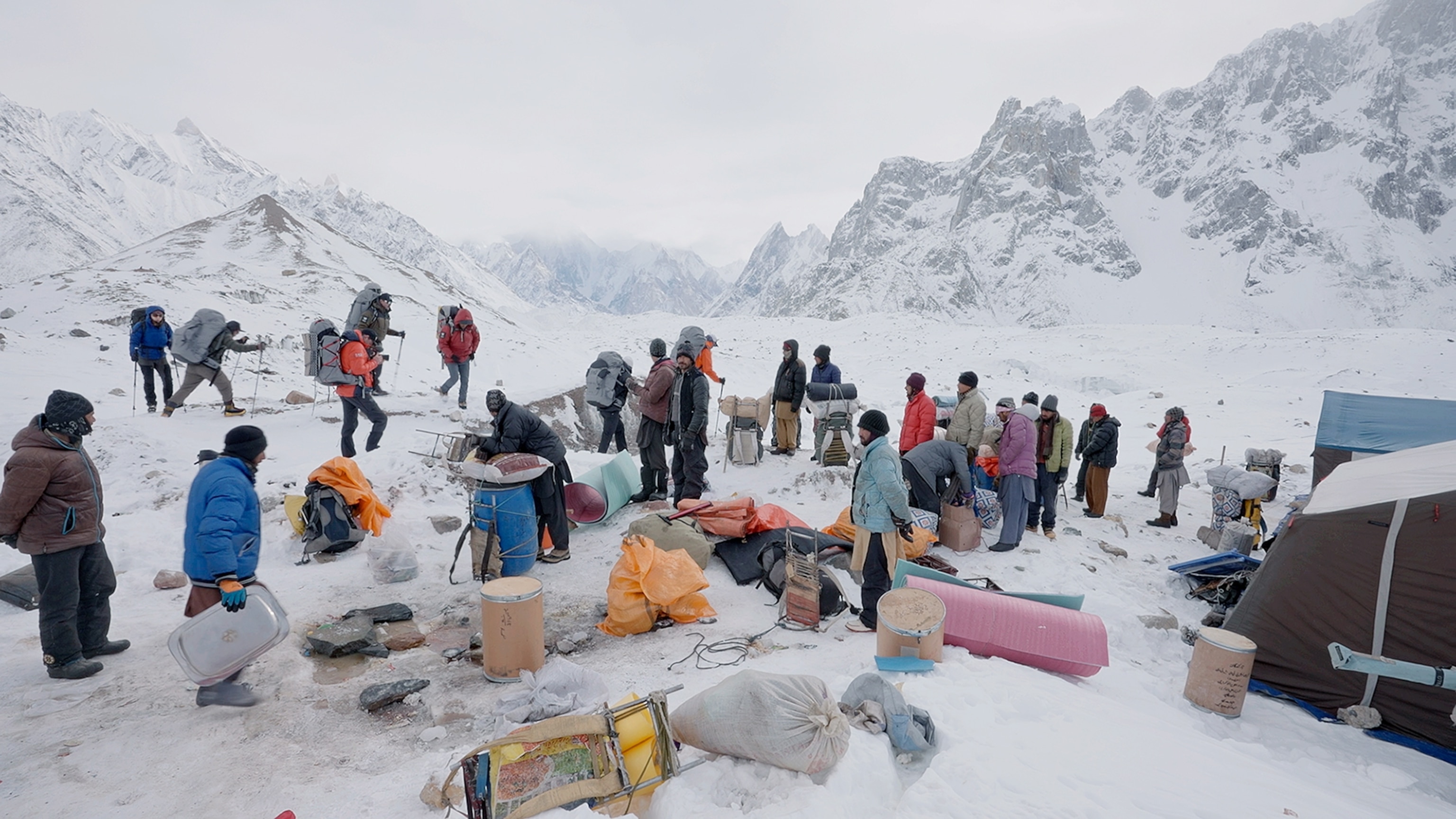
By 2020 the notion of groundbreaking mountaineering achievement seemed like an anachronism. Midway through the past century, all of the world’s highest summits—the 14 mountains that top 8,000 meters—had been climbed. First came Nepal’s Annapurna I in 1950, then Everest and Pakistan’s Nanga Parbat in 1953; the rest fell in succession until Tibet’s Xixabangma was claimed in 1964.
It was a fevered run of nationalistic efforts, and though all the mountains were in Asia, European teams claimed the majority of these prizes. And while virtually every expedition of this era relied on local ethnic groups, including the Sherpas, Tibetans, and Baltis who transported gear to the Base Camps and carried loads up the mountain, the true contributions of these indispensable partners rarely were acknowledged in the history books.
(In this episode of our podcast Overheard, Mingma Gyalje Sherpa tells the story of the epic journey on what experienced climbers call the Savage Mountain. Listen now on Apple Podcasts.)
With these landmark first ascents accomplished, Polish mountaineer Andrzej Zawada came up with a new challenge. All the eight-thousanders had been climbed in summer, during the most favorable conditions. More difficult, he reasoned, would be to climb them in winter, their harshest season. Zawada led an expedition that put two climbers on the summit of Everest in the winter of 1980 and set Poland on a historic string of winter firsts. One by one, the eight-thousanders fell, but Pakistan’s peaks stubbornly resisted winter mountaineers well into the 21st century. Located eight degrees of latitude north of the Nepali peaks, the Karakoram Range is notably colder and windier in winter. It took 31 attempts before Nanga Parbat finally was climbed in 2016, leaving only K2.
(How climbers faced down the ‘death zone’ on one of Earth’s tallest mountains)
Although overshadowed by Everest in the popular media, K2 is considered a far greater challenge by serious mountaineers, partly because of its extreme remoteness. When the British survey team recorded the first elevations in the Karakoram in 1856, they replaced their survey designations with local names. K1, for example, was known by the local name Masherbrum. But since K2 isn’t visible from the closest village, Askole, a week’s trek from the peak’s base, it hadn’t been named.
After four days’ hiking over rough terrain, K2 comes into view from the south, its iconic pyramidal form rising like an arrowhead pointed at the heavens. Climbers quickly note its steepness, especially near the top, which means that any mistake is magnified to near-fatal consequences. Trip over your crampons or clip into an unsecured line by mistake, and it’s unlikely you’ll stop falling before hitting the glacier thousands of feet below.
Because the margin for error is even further reduced in winter, success, or really survival, comes down to logistics—planning for the worst conditions and nightmarish scenarios. Colossal peaks, such as Everest and K2, are rarely climbed in a single linear push. Rather, teams generally move up and down the mountain, acclimatizing to higher altitudes while setting up a network of fixed ropes and camps stocked with critical gear, such as oxygen bottles, tents, and ropes. In recent years, the notion of a faster, lighter style of alpinism has prevailed, but K2 in winter calls for an old-school group effort: Individuals must haul several heavy loads over dangerous terrain. It demands old-fashioned teamwork.
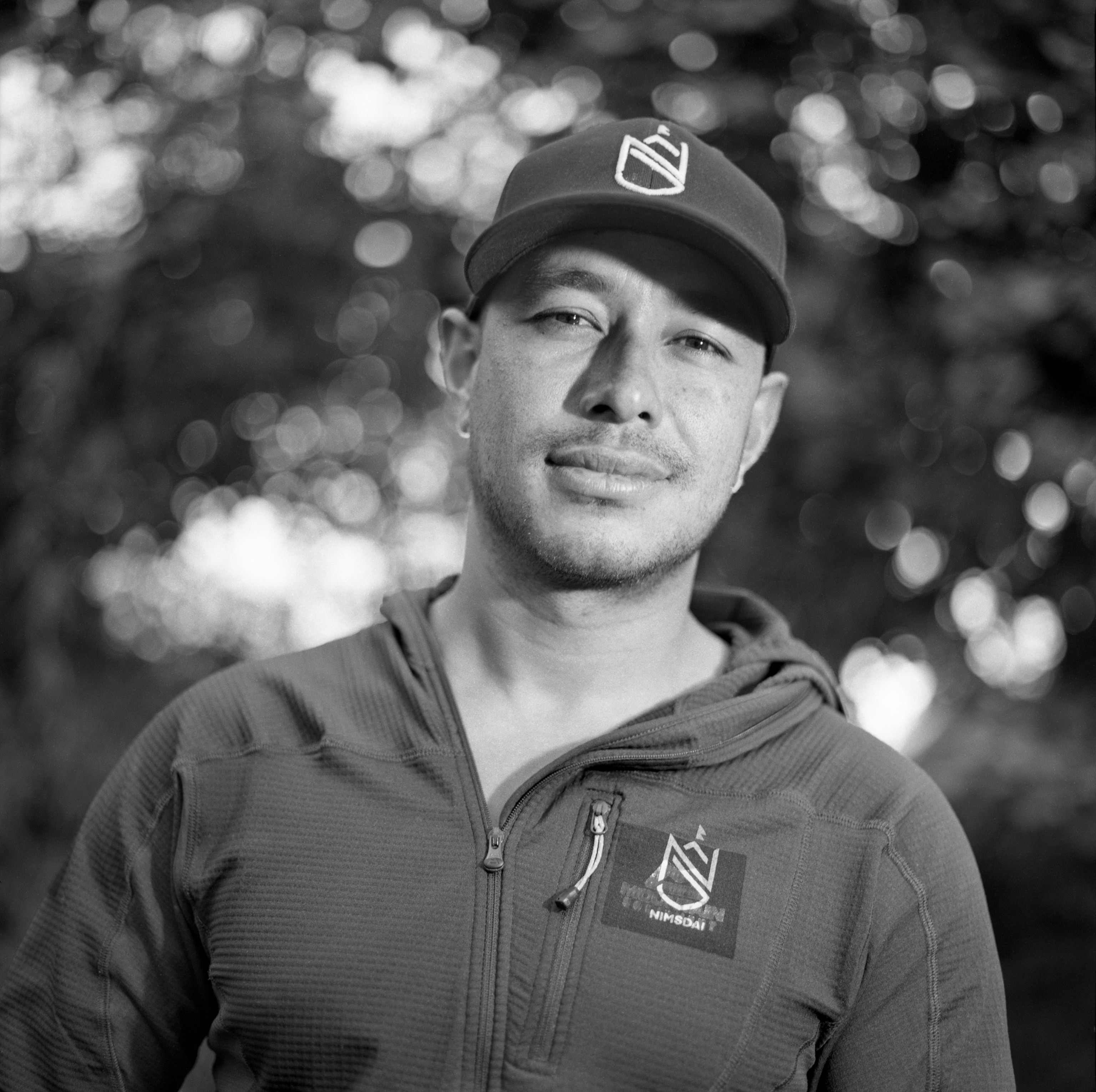
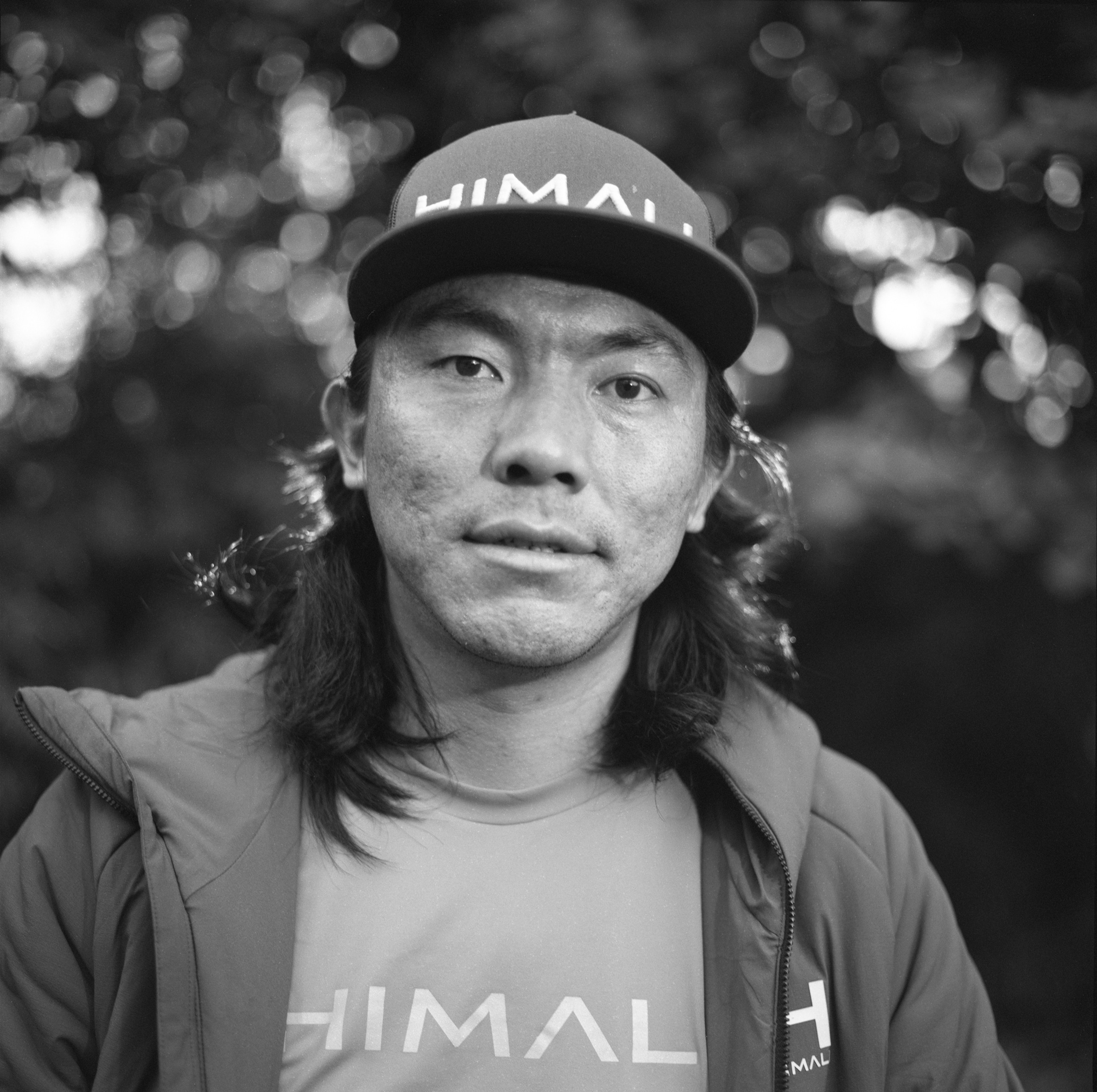
Mingma G. stands five feet nine inches, tall for a Sherpa. He’s 33, broad-shouldered, and often wears his hair in a thick mop extending past his collar that is vaguely reminiscent of a 1970s rocker. He tends to look people in the eye when he speaks and has a way of cutting directly to the point that seems to add weight to his words.
He grew up in Rolwaling, a narrow valley west of Everest. It’s far from the bustling Khumbu Valley, yet Rolwaling has produced some of the most renowned Sherpa mountain guides. Mingma G. grew up listening to his father and uncles, all of whom worked as guides, tell tales of Mount Everest around the kitchen stove on cold winter nights. The stories they told weren’t so much about the foreign mountaineers who flooded Nepal each spring as they were about homegrown heroes such as Pasang Lhamu Sherpa, who in 1993 became the first Nepali woman to summit Everest and died on her way down, and his first cousin Lopsang Jangbu Sherpa, who assisted climbers during the 1996 disaster made famous by the book Into Thin Air and then tragically died four months later.
In 2006, when Mingma G. was 19, his uncle took him on his first expedition to Manaslu. The next year, Mingma G. summited Everest while working for a French outfitter, and by 2011, he was organizing and leading his own expeditions. Those were difficult years. From 2001 to 2008, Nepal was gripped by a violent Maoist insurrection, and many international mountaineers stayed away. Competition to guide the few who dared to come to Nepal was intense.
In the winter season of 2019-2020, Mingma G. cobbled together his own attempt to claim the first winter summit of K2 with three paying clients. Life at Base Camp—which at 16,272 feet sits nearly 1,800 feet higher than Mount Whitney, the highest point in the continental United States—was itself a severe trial. “If we washed our clothes, then it takes more than a week to get it dry unless we dry them on gas heater or stove,” he wrote to mountaineering journalist Alan Arnette.
After arriving at Base Camp, Mingma G. caught an upper respiratory infection and had to withdraw from the expedition. But it wasn’t long before he began thinking about trying again.
And then COVID-19 struck. Tens of thousands of guides, porters, and cooks were out of work across the Himalaya. Within weeks of returning from K2, Mingma G.’s entire year of guided climbs evaporated, leaving him with no income and a small business to support. He tried to talk a few friends into another attempt on K2, but nobody wanted to spend the $10,000 for a permit just to reach Base Camp, plus tens of thousands more to mount a no-frills effort.
Many Nepali mountaineers had been part of groundbreaking climbs, but no all-Nepali team had claimed a historic first ascent on its own.
Mingma G. considered dropping the idea, but something gnawed at him. Tenzing Norgay, a Sherpa, was one of the first two people to stand on top of Everest, and though he was a national hero with his photo proudly displayed in countless Nepali homes, he had shared the achievement with Edmund Hillary of New Zealand. Nepali climbers had been part of other groundbreaking climbs, but none had ever claimed a truly historic first ascent all on his or her own.
“When I went through Wikipedia, there was no Nepalese flag on the winter 8,000-meter list,” Mingma G. says. “I realized if we lose K2, we’re going to lose all the 8,000-meter peaks.”
He knew he’d have to spend the money, even if it meant mortgaging the piece of land he’d bought in Kathmandu, which represented most of his savings. He was able to recruit two brothers, Kilu Pemba and Dawa Tenjin Sherpa, both older than he, with wives, teenage children, and decades of high-altitude experience.
But their families had reservations. “It was very difficult for me to convince the wives of Kilu Pemba and Dawa Tenjin,” recalls Mingma G., who is unmarried. “They said, ‘If our husbands die, then we’re going to come stay in your home and you need to feed us.’ That made me a little crazy … and very worried.”
(Stunning photos capture Earth's highest peaks at their deadliest)
There was another problem. After years of back-to-back expeditions and the demands of running his own business, Mingma G. faced a startling realization for a Sherpa: He was out of shape. As he waited in Kathmandu for the pandemic to subside, a family member began coaxing him out for hikes and bike rides. “I lost many kilos and started feeling strong again,” he says.
Mingma G. wasn’t the only Sherpa with K2 in his sights. A trio of brothers—Mingma, Tashi Lakpa, and Chhang Dawa Sherpa, the principal owners of Seven Summit Treks—realized that Pakistan was one of the few mountaineering destinations still open in the high mountains of Asia.
By charging fees below those of Western outfitters, Seven Summit Treks had established itself as one of the most successful Sherpa-owned expedition companies and routinely fielded one of the largest groups on Everest each season. That March, contemplating its own disastrous year of cancellations, Seven Summit posted inquiries on social media to see if any clients might be interested in a winter K2 expedition. It quickly booked one in full, with climbers from Russia, Spain, Ireland, Turkey, and the United Kingdom.
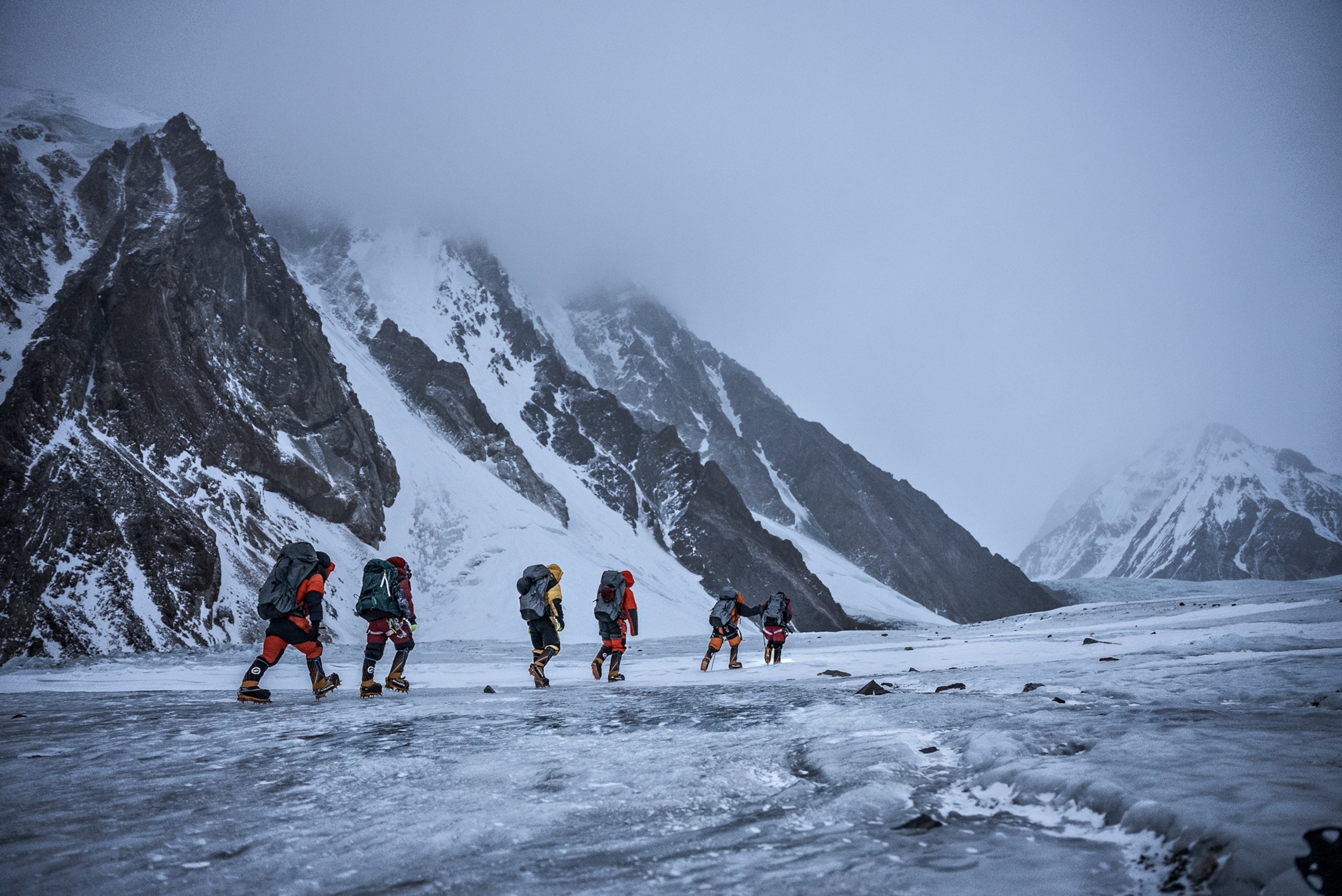
On December 21, 2020, the first calendar day of winter, Mingma G. and his two teammates started up K2. Several days later, they were camped at 22,600 feet, below a section known as the Black Pyramid—a near-vertical mass of crumbling rock, the first major technical challenge. It would take a full day of precise climbing with heavy packs to reach Camp III, the launchpad for a serious attempt on the summit. But they had a problem: a shortage of rope.
Mingma G. knew that several teams were acclimatizing at the camps below them, including another Nepali team led by a flamboyant former special forces soldier turned climber named Nirmal “Nims” Purja. Mingma G. and Nims had met before, briefly. “We didn’t have any formal introductions,” Mingma G. says. “We just shook hands once, and I said, ‘I’m Mingma G.’ … It was not necessary for him to introduce himself.”
That was in 2019, when Nims was in the midst of a record-setting six-month, six-day blitz to climb all 14 of the world’s 8,000-meter peaks. The media had taken notice, and Nims went from relatively unknown to social media darling.
(Nepal climber makes history speed-climbing world's tallest peaks)
In truth, the two men couldn’t help but feel a bit of rivalry. Both were extremely capable leaders in their physical primes, who were experts in one of the world’s most dangerous pursuits. But they had very different styles: Mingma G. was reserved and no-nonsense; Nims was brash and funny and, true to form, had announced to his social media followers his objective to be the first on K2 in winter.
Nevertheless, Mingma G. figured he’d radio down and ask Nims if he had rope to spare. Even though Nims’s team had just arrived on the mountain and the men weren’t yet acclimatized, they volunteered to carry some up. The two teams chatted over tea the next morning at the camp just below the Black Pyramid and discovered that neither had brought foreign clients. They all wanted K2 for themselves.
The next day, everyone descended all the way down to Base Camp to recover. A gray sky seemed to filter all the color from the glacier, and a persistent wind raked streams of ice crystals among the flapping tents. It was December 31, and with a bad forecast in the offing, it was time to get some rest—if that was possible in such an inhospitable place.
That evening, Nims dropped by Mingma G.’s mess tent to invite the rival team to a New Year’s celebration. At first, Mingma G. wasn’t in the mood to go, but Nims sent two teammates to persuade him to join the festivities.
Stripped of his high-altitude gear, Nims cuts a youthful figure, his smooth cheeks and thin wisps of facial hair belying his 37 years. The former soldier prides himself on being prepared. “That’s one thing you learn in the army, mate,” he says, his speech peppered with the slang of an English pub. “Everything has a backup plan. My backup plans have backup plans, man.” When Mingma G.’s team arrived at the party, Nims promptly uncorked a bottle of whiskey.
“When we finished that one, we started feeling a little dizzy,” Mingma G. recalls. “Then Nims opened another one, and then another one, and then another one.” Soon everyone was dancing and discussing the weather and the plan.

Nims is not an ethnic Sherpa but a Magar—an indigenous ethnic group from the middle hills of Nepal. He grew up in Chitwan, a low-altitude district, more famous for elephants and tigers than snowy mountains. At 18 he enlisted in the Gurkhas, a British military regiment of Nepali soldiers that exists as a vestige of the British Empire. Along with becoming a mountain guide, joining the Gurkhas is one of the best professional opportunities available to ambitious Nepali men: Gurkhas receive pay on par with British soldiers and have the right to gain British citizenship.
After six years in the Gurkhas, Nims joined the Special Boat Service, a unit akin to the U.S. Navy SEALs. “We’ll just say I have been deployed in sensitive areas, that’s it,” he said in a 2019 interview. But he discusses his military experiences, including a firefight in which he was shot in the face, in more detail in his recent book.
“In the special forces, the things you are doing … you feel invincible,” Nims muses. “But then when I went to the mountain, it was very clear that nature has bigger things to say.” In 2019 he resigned from the military to become a professional mountaineer and pursue his dream project: climbing all 14 of the eight-thousanders in seven months. The idea had been bandied about before, but nobody seriously had undertaken the challenge.
Dubbing his effort Project Possible, Nims recruited a crack crew of Nepali guides to help prepare routes and climb with him, much like a Tour de France team deploys riders to pace their leader. After summiting one mountain, he headed straight to the next, sometimes via helicopter, which allowed him to maintain his acclimatization to higher altitudes. And he made ready use of bottled oxygen and in some places relied on ropes fixed by other teams, which purists argued cheapened the achievement.
Now, more than a year later, his K2 team included a core veteran of that group, Mingma David Sherpa, a sprightly 31-year-old guide who serves as Nims’s chief deputy. The old man of the new team was Pem Chhiri Sherpa, a 42-year-old Rolwaling Sherpa with 20 years of Everest experience. Nims also recruited Dawa Temba Sherpa and Mingma Tenzi Sherpa, both highly experienced mountaineers. The last team member was the youngest: Gelje Sherpa, a 28-year-old guide with an infectious sense of humor.
As Gelje told jokes and deejayed the New Year’s Eve party, an idea started to percolate between the two teams: Why not join forces? As Pem recalls, the benefits were obvious: “It sped up the work, and we started working together. It became easier because we all were Nepalese.”
As Gelje told jokes and deejayed the New Year’s Eve party, an idea started to percolate between the Nepali teams: Why not join forces?
Sherpas who work in mountaineering have a reputation for generally being easygoing, displaying a Buddhist sense of detachment toward life’s trials, but the profession takes a heavy toll. In addition to the physical pain—faces burned by frostnip, arthritic joints, and chronic back problems—they’d all lost friends and relatives to mountaineering. The past seven years had been particularly cruel. An avalanche in 2014 killed 16 of the most experienced Sherpas on Everest and brought the climbing season to a halt, and in 2015 an earthquake killed 19 people at Everest Base Camp and about 9,000 across the entire country. Now the pandemic had cost them another year’s work. They also knew the bitterness that comes with a thankless job. “Few foreign clients acknowledge our help, describing us merely as nameless high-altitude porters or pretending that we don’t exist,” Mingma G. says. “It’s like they think we don’t read their articles.”
And then there were the growing tensions, as Nepali outfitters wanted more of the lucrative guiding business that for years was dominated by foreign companies. “We are the local people, and we know more than the foreign guide services do,” Mingma G. says. He acknowledges that there is fierce competition among Nepali outfitters, but “90 percent of foreign climbers, they only trust foreign companies.”
Claiming the first K2 winter summit would serve notice that Nepalis were taking their rightful place not just as participants but also as leaders in the mountaineering world. “We wanted to have one for ourselves, for history,” Nims would explain later. “It was a no-brainer to team up.”
Mingma G. woke up on New Year’s Day with a foggy hangover. Despite the subzero temperatures, he had fallen asleep in his tent without crawling into his sleeping bag. Soon he heard Nims’s voice on the radio, inviting him back to his camp for tea. They had more plans to discuss.

Sherpas like to say that a mountain must allow a team of climbers to reach its summit and return unharmed. It’s the reason every Himalayan expedition performs a Puja ceremony: to ask the mountain deities for permission to climb and for safe passage. But during the first two weeks of 2021, it was abundantly clear that K2 was not ready to welcome any humans near its apex. Hundred-mile-an-hour winds scoured the mountain for days and plunged temperatures well below zero at Base Camp, forcing everyone to hunker down in their tents.
When the winds let up slightly, Nims’s team made a quick foray up to Camp II to check on their gear. “It was a wreckage sight,” Nims wrote on Instagram. Gear they’d left for the summit push—sleeping bags, battery-heated insoles for their boots, spare mittens, and goggles—had all blown away.
But weather reports predicted the winds would calm beginning on January 14. Back at Base Camp, more gear was quickly rounded up, and another Nepali, Sona Sherpa from Seven Summit Treks, joined the group to help bring it up. Meanwhile, Nims and Mingma G. reassessed their schedule for reaching the summit. Rather than spend a frigid night at Camp IV, the traditional high camp pitched at roughly 25,000 feet for a summit bid, the Nepalis planned to reach the top in a single day from Camp III. If everything went well—a huge if—they could summit on the 15th.
Later, some climbers at Base Camp would accuse the Nepalis of hiding their plans to maintain an all-Nepali summit team, an accusation Mingma G. doesn’t shy away from. “When there is a football World Cup, do you ever want your country to lose?” he explained in an interview with ExplorersWeb. “No, never. And the team and the coach always keep the strategy secret to make those wishes possible. We were the same on K2 this time.”
By the evening of the 13th, as the Nepalis reached around 23,000 feet, the secret was out and several parties started up the mountain after them. The next morning, while those teams rested at Camp II in a biting wind, the Nepalis pushed upward to just below Camp III. “The weather played a big game,” Mingma G. says. “Below Camp III, there was big wind, and above Camp III, there was no wind at all.”
On the 15th, Mingma G. and three others set out to fix ropes above Camp III, toward a section known as the Shoulder, but as they navigated their way up the seemingly endless snow slopes, a maze of crevasses—human-swallowing cracks in the glaciated terrain—blocked their way. Just short of reaching the traditional spot for Camp IV, they encountered a huge crevasse, forcing them to backtrack for hours to find a way around it. It was the type of exhausting, morale-breaking setback that often drives mountaineers to abandon an expedition, but Mingma G. and the others pushed on. After finding a section of hardpack—a snowbridge—across the crevasse field, they fixed lines all the way to the Shoulder.
They returned to Camp III and joined the rest of the team for a few hours of fitful rest. “It was a different kind of cold,” Gelje remembers. “It made you very thirsty. It was hard to digest the food you ate.”
Sometime after midnight on the 16th, the team began to gear up to leave Camp III. For the first time on the mountain, each man donned an oxygen mask for the summit push, all except one. Nims had decided to answer his critics by climbing the Savage Mountain in winter without oxygen, a landmark achievement on top of a landmark achievement—if he could pull it off. “I wasn’t fully acclimatized. I had frostnip on three fingers,” Nims says. “If you don’t really know your ability, your capacity, you could ruin it for everyone.”
In small groups, the mountaineers began following the route up the lines Mingma G. had laboriously fixed to the Shoulder. His hard-fought effort paid off. What took eight hours the previous day now took only three in the dark, but a vicious wind had kicked up.
Feeling alone and sensing the onset of frostbite, Mingma G. was on the verge of calling off his summit attempt. But when no one answered his radio call, he resorted to his last option: kicking his feet into the ice to keep them warm. “Amazingly, it worked,” he says.
At last, the first rays of dawn hit most of the mountaineers on the Shoulder, warming their bodies. The wind dropped, and despite the still arctic temperatures, it was a perfect day. Above loomed the final crux of the route, the Bottleneck—a frozen couloir beneath an overhanging wall of ice known as a serac. Beyond the couloir, the climbers would face easy slopes leading to the summit, but if a portion of the serac collapsed while one of them was in the Bottleneck, it likely would be fatal to anyone below it. As if to remind the climbers of the danger, ominous refrigerator-size ice blocks lay scattered in a field beneath the couloir.
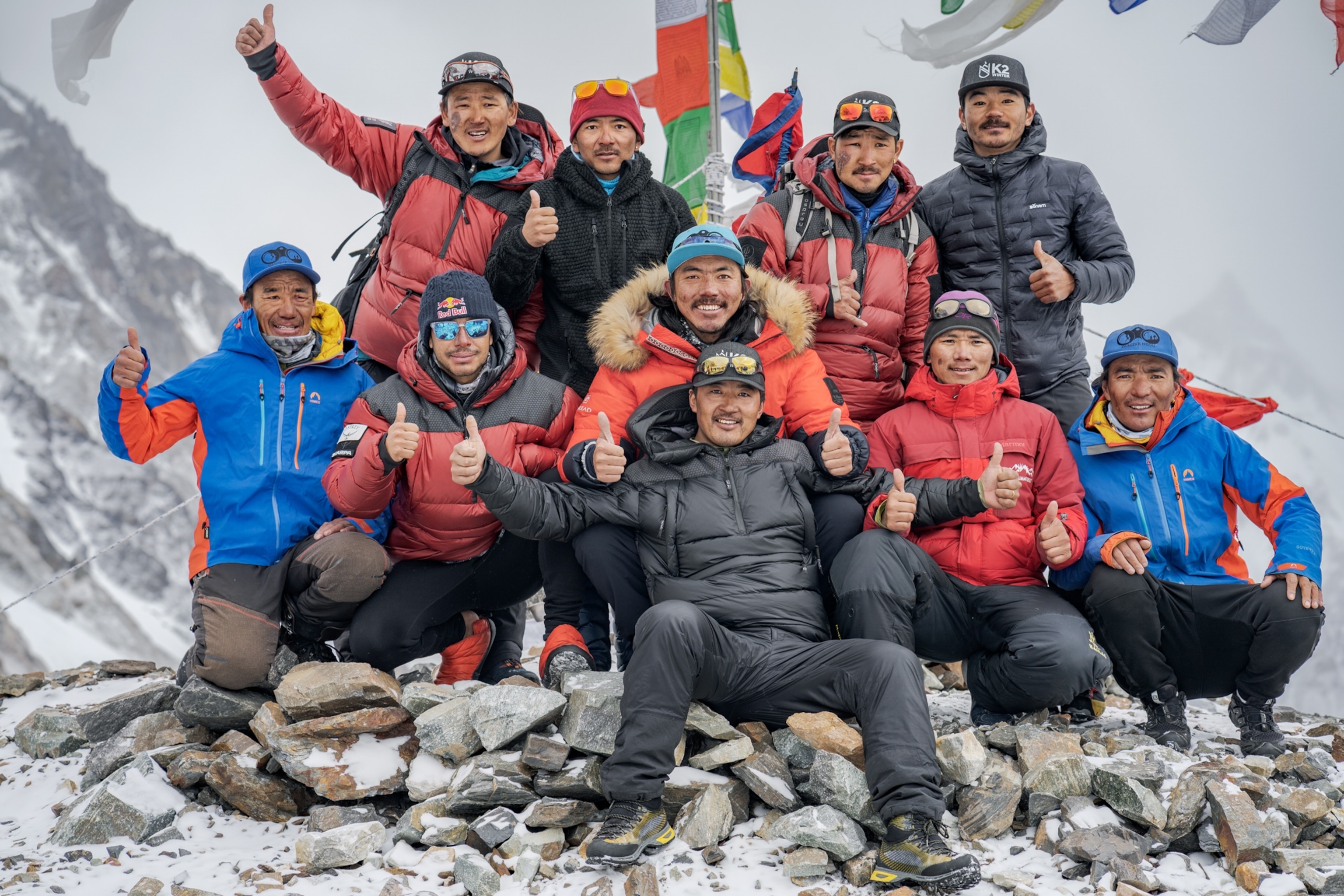
Mingma Tenzi and Dawa Tenjin led the team through the treacherous passage, fixing lines behind for the others to follow. As they worked their way up, small rocks clattered down the couloir, occasionally striking someone’s helmet. There was little to do but carry on.
As the group neared the summit, neither Mingma G. nor Nims was in front. That job had fallen to Mingma Tenzi, a 36-year-old rope-fixing specialist with a cheerful smile and a gold tooth. He led the team for the last few hours and could have reached the top ahead of the others, but he stopped just below the summit.
One by one, the mountaineers steadily moved up to join him. Nims labored heavily in the frozen empty air, taking two or three breaths for every step. As the sun twinkled on the gentle crest of snow draped over the second highest point on the planet, the climbers coalesced into a single group.
Reaching the summit together had been Nims’s idea, and when all 10 had gathered, they linked arms and began trudging upward. Slowly, they found their voices, and as if in a dream, the words of the Nepali national anthem came to them:
Woven from hundreds of flowers ...
A shawl of unending natural wealth ...
A land of knowledge and peace, the plains, hills, and mountains tall ...
Unscathed, this beloved land of ours, O motherland Nepal.
Author and mountain guide Freddie Wilkinson wrote about the National Geographic and Rolex Perpetual Planet Everest Expedition for the July 2020 issue.
This story appears in the February 2022 issue of National Geographic magazine.
To learn more about Nims Purja's journey from rural Nepal to joining the legendary Gurkhas to his record-setting mountaineering exploits, check out Beyond Possible: One Man, Fourteen Peaks, and the Mountaineering Achievement of a Lifetime

